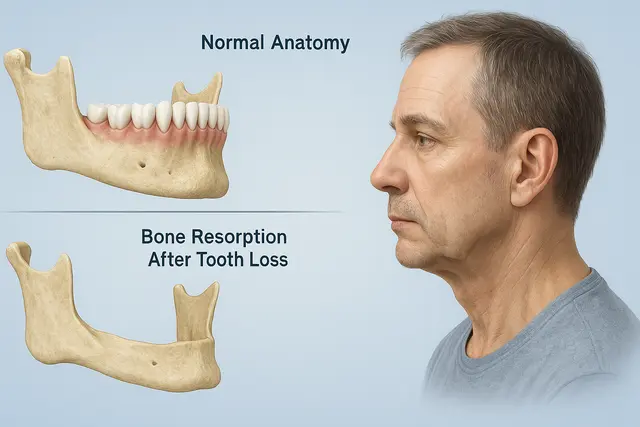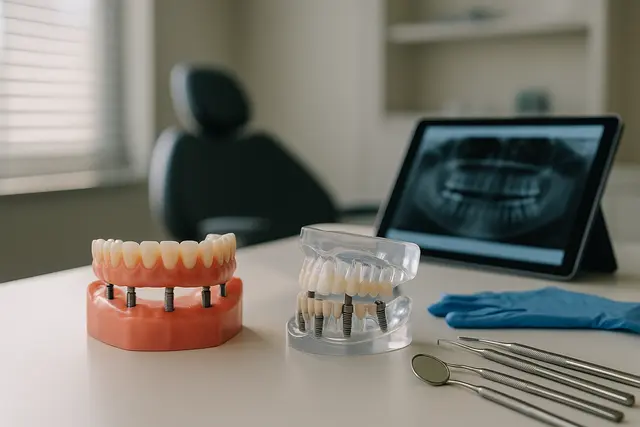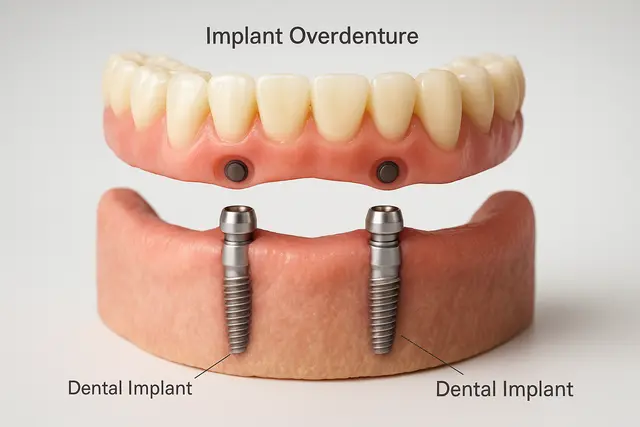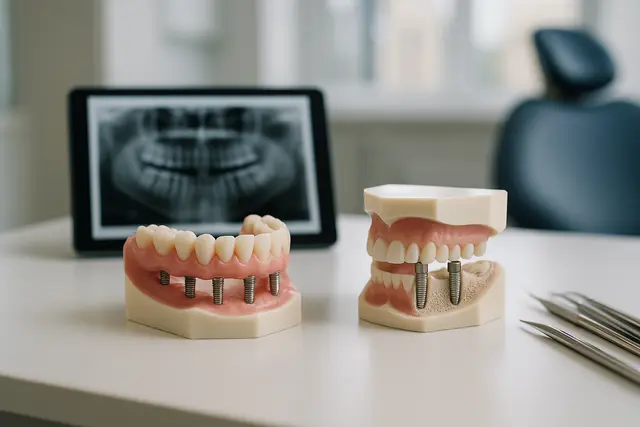Prosthodontics
4 min read
Oct 14, 2025
What Is Bone Resorption After Tooth Loss? Symptoms and Solutions
Losing a tooth affects more than just your smile, it can trigger hidden changes beneath the surface that impact your long-term oral health. One of the most serious consequences is bone resorption, a process where your jawbone begins to shrink after tooth loss. Understanding why this happens and how to stop it is key to preserving your facial structure, confidence, and overall dental health.

Tooth Loss and the Start of Bone Loss
When a tooth is removed or falls out, your body kicks into a natural response called bone resorption. Essentially, your body thinks, "Hey, we don’t need this bone anymore," and starts to break it down. This happens in the alveolar bone, the part of your jaw that once supported your tooth root.
Why does it matter? Because that bone is like the foundation of your smile. Lose it, and your adjacent teeth may shift, your bone structure can change, and your face might even take on a sunken look over time.
What Causes Bone Loss in Your Jaw
When you lose a tooth, the absence of chewing pressure from the natural tooth roots means your bone cells no longer get the stimulation they need. Over time, this leads to a decrease in bone density, a weakening of the bone tissue, and a slow but steady loss of bone mass.
The resorption process gets worse the longer the area goes untreated. Other factors like periodontal disease, severe tooth decay, or trauma can also kickstart bone loss in your jaw.
Symptoms That Point to Bone Resorption
This isn't always something you feel right away. But here are some signs to watch for:
Your denture feels loose or doesn’t fit like it used to
You notice a sunken or sagging look around your mouth
Eating becomes uncomfortable
Your jawbone feels thinner or more fragile
If you’ve had a tooth extraction, it’s smart to keep an eye on these signs. Jawbone loss doesn’t announce itself with fireworks, but it slowly chips away at your bone height and density.
Bone Remodeling and How the Body Reacts
The human body is pretty incredible. It constantly replaces old bone with new bone in a process called bone remodeling. But after a dental extraction, that system doesn’t get the right signals. Instead of building healthy bone, the body just stops maintaining it.
This is where resorption following tooth extraction comes in. Within just 12 months of extraction, you can lose up to 25% of bone density in the area. That’s a serious shift, especially if you plan on getting a dental implant later.
Dental Implants and the Role They Play
Here’s the good news: a dental implant acts like a natural tooth. It doesn’t just fill the gap in your smile; it stimulates bone just like your old tooth root did.
That’s why dentists often recommend implants as soon as possible following tooth extraction. If you wait too long and bone loss progresses, you might not have sufficient bone to place an implant at all.
Enter the bone graft.
Bone Grafts and Bone Regeneration
If bone loss in your jaw has already begun, don’t panic. A dental bone graft can help rebuild what you’ve lost. This procedure uses synthetic bone, your own tissue, or bone graft material from a donor to jumpstart new bone formation.
Over time, this encourages bone regeneration, bone growth, and new bone tissue to form. Add in some growth factors like platelet-derived growth factor, and your body gets the boost it needs for proper bone healing.
Depending on the case, your dentist might perform the bone graft immediately after tooth extraction to prevent alveolar ridge resorption or as prep for a future implant.
How Bone Defects Develop After Extraction
When teeth are lost, the extraction socket left behind can collapse. Without the support of a tooth, the area is prone to bone defects and alveolar bone loss. If the mandibular bone (the lower part of your jaw) is involved, it can seriously affect how you chew, speak, and look.
The underlying bone becomes less stable, and over time, this loss of bone may lead to jawbone loss that can only be corrected surgically.
Preventing Bone Resorption and Preserving the Jaw
So, how can we prevent bone resorption and keep your bone strong?
Replace missing teeth quickly with implants or dentures or dental bridges.
Talk to your dentist about bone grafting before or immediately after tooth extraction.
Keep gum disease at bay with regular dental visits and good hygiene.
The prevention of bone deterioration isn’t just about your smile’s appearance. It’s about preserving bone health, bone mineral density, and your ability to eat, talk, and live comfortably.
Treatment Options to Reverse or Slow Bone Loss
The right treatment options depend on how much bone mass and density you’ve already lost. Some common approaches include:
Dental implants to restore function and support
Bone grafts to restore bone volume
Special membranes to guide bone formation during healing
Medication to reduce the resorption rate or stimulate bone regeneration
In many cases, these strategies can rebuild enough natural bone to support a replacement tooth that feels just like a natural tooth.
Why Acting Fast Matters
When you lose a tooth, the clock starts ticking. The longer you wait, the more your alveolar bone will deteriorate, and the harder it will be to fix.
Periodontal bone loss and untreated extracted teeth are a recipe for complications that ripple through your mouth. That’s why we always say: if you're facing tooth removal, plan your next move right away.
Don't wait for the resorption process to get ahead of you. Your bone health and your future smile are worth the attention.
What Happens to the Jawbone After Tooth Loss?
When a tooth is lost, the jawbone that once supported it begins to shrink through a process called bone resorption. Without stimulation from chewing forces transferred through the tooth root, the body starts to break down the alveolar bone, assuming it's no longer needed. This can lead to changes in facial structure, shifting teeth, and a weakened foundation for future dental work like implants or bridges.
What Are the Early Signs of Bone Resorption in the Jaw?
Bone resorption can be subtle at first, but signs may include a loose-fitting denture, visible sagging around the mouth, difficulty chewing, or changes in your bite. Some patients also notice discomfort or a hollowed feeling where the tooth once was. Regular dental exams after tooth loss are key to catching bone loss early.
How Can Dental Implants Help Prevent Bone Loss?
Dental implants mimic natural tooth roots, stimulating the surrounding bone and preventing the resorption that typically follows tooth loss. When placed soon after extraction, they preserve bone density and provide long-term support for prosthetics. Waiting too long without treatment may require bone grafting before implants can be placed.
What Options Exist to Reverse or Slow Down Bone Loss?
Several treatments can help reverse or reduce bone loss, including dental bone grafts, membrane-guided bone regeneration, and even medications that promote bone growth. Promptly replacing missing teeth with implants or bridges and maintaining excellent oral hygiene are also essential for preserving the jawbone’s strength and shape.
Read Next
Related Posts

Prosthodontics
Implant Supported Dentures Overview
Missing teeth can impact more than just your smile, they can affect your confidence, comfort, and even your diet. Fortunately, modern dentistry offers a solution that’s both secure and natural-looking: implant-supported dentures. This innovative approach blends the stability of implants with the convenience of dentures to create a long-lasting, life-improving upgrade.
5 min read
Oct 29, 2025

Prosthodontics
Implant Overdentures Explained: The Hybrid Solution to Missing Teeth
Missing teeth can impact everything from your ability to eat to your self-confidence. While traditional dentures have long been a go-to solution, they often fall short in comfort and stability. Implant overdentures offer a modern alternative that combines the security of dental implants with the convenience of removable dentures, a true upgrade for those looking to reclaim their smile.
6 min read
Oct 29, 2025

Prosthodontics
Implant Retained Dentures Explained
Considering implant-retained dentures? You're not alone. As modern dentistry evolves, more people are turning to this secure, natural-feeling alternative to traditional dentures. This guide will walk you through what they are, how they work, and why they might be the solution you've been looking for.
4 min read
Oct 28, 2025
Don’t have time to research every dentist around you?
See why 30k+ patients trusted us